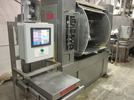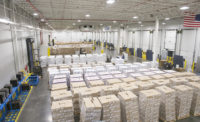Batch control system helps one frozen baker eliminate "out-of-spec" batches, improve lot tracking.

Squeezed by rising commodity cost and price conscious consumers, wholesale bakers and other food processors are re-examining processes to minimize waste and inefficiency.
By avoiding operator error with advanced batch and lot tracking systems, some of the most proactive producers are eliminating “out of spec” batches to save from 5 to 8 percent on ingredient cost and are typically achieving a return on investment (ROI) within three to six months.
It used to be common for operators to apprentice under experienced bakers to learn the business. For instance, today’s bakery operators are usually less well-trained and more prone to making mistakes on the plant floor.
When operators improperly set bulk dispensing equipment, forget to hand add an ingredient, or mix the batch for the wrong length of time, the batch can become a total loss. These sorts of problems can result in excess scrap, unaccounted inventory losses, and inventory shortages that stop production, and can cost tens of thousands of dollars every month.
It is particularly difficult for management to troubleshoot problems on the plant floor when operators are asked to create paper records of production operations. These records are frequently inaccurate, not just because operators must interrupt their other tasks to create them, but simply because of human nature.
Modern Italian Bakery, Oakdale, NY., produces artisan breads and specialty items. It makes fresh regional product and a frozen line that is distributed nationally.
“The standard mixer report that most bakers use asks mix operators to record their mistakes, but most people will not do that with 100 percent honesty,” says Julio Llovet, Modern Italian Bakery's director of operations.
“According to our previous mixer reports done by hand, every batch was to spec every day, yet material waste and inefficiency was a problem,” admits Llovet. “We ended up ‘chasing our tail’ trying to figure out what the problems were.”
Eliminate operator error
Seeking to reduce waste, troubleshoot more effectively, and provide full lot traceability, Llovet turned to an advanced batch and lot-tracking system called PRIMS (Product Recipe Ingredient Management System) from Focus Works, Patchogue, N.Y.
PRIMS is a personal computer-based automation solution integrated with PLC-based operator control stations on the plant floor. It is based on the premise that the only way to prevent operators from making mistakes is to confirm and verify everything they pre-scale and add into the mixers, thereby removing their ability to deviate from the set recipe. With the product installed, operators cannot make a batch that does not meet the recipe specification, in terms of required ingredients, proportions, as well as mixing time, speed, and dough temperature.
After a baking company loads its recipes into the product’s database, those recipes are sent to control stations on the bakery floor as needed to meet daily production schedules. Recipe software then “walks” the operator step by step through the recipe on a multilingual display at the control station, which is connected to the mixer, necessary scales, temperature probes, and other equipment.
If everything is according to spec, the system lights up a green “acknowledge” button; once the operator presses the button, he is allowed to proceed to the next step. If anything is out of spec, the acknowledge button remains dark and the operator is prompted to correct the mistake. If an operator goes outside the prescribed recipe, the deviation is recorded by the system, along with operator ID, so management can take corrective action.
“As soon as we installed PRIMS we realized that 90 percent of the information logged in our mixer reports was inaccurate,” says Llovet. “When we realized where the deviation points were, it took less than a week to put in the corrective actions."
He continues, "Within six months, we reduced our out of spec doughs from about 15 percent to 2 percent, and reduced our overall waste from about 9.0 percent to 3.5 percent. It took about three months to achieve ROI. It was like I was managing in the dark and somebody turned on the lights because of all the controls we now have.”
For instance, while one operator had listed dough temperature in the standard 77 to 78°F range, when temperature probes were installed and used by operators as prompted, the system found some dough temperatures actually in the low 80s°F.
Because the operator was told to put in ice but did not, Llovet changed the ingredient formula to force the operator to weigh the required ice as a necessary step. Now everything that goes into the mixer is weighed and verified, including scrap.
“Within about two minutes, I was able to modify the recipe to require the operator to add ice to a specified tolerance,” says Llovet.
According to Llovet, the system controls and records the use of both hand-adds and bulk ingredients, at a pre-scale station and at eight mixer operator stations. It also controls and logs mix time/speed, water temperature, dough temperature, refrigeration settings and more.
“Previously, some of our operators would forget to hand-add an ingredient,” says Llovet. “We were probably losing about 14 doughs a week with no yeast. Now because each ingredient and all raw materials are recorded, we have no ‘mystery doughs’ and all missing ingredients can be tracked. Since the operator has no choice but to go step by step, the recipe does not let them proceed until they get it right, and every ingredient and step is recorded automatically, it takes human error out of it.”
Because Modern Italian Bakery runs a 24/7 operation, Llovet says he appreciates being able to use his laptop at home to pull reports to see how his operators are doing in real-time. As he has given his operators daily and weekly feedback via key performance indicators, such as final dough temperature and productivity over time, he says his operators have steadily improved their work performance.
“Now my mix operators refuse to mix with anything else,” says Llovet. “The software walks them through all the steps, one by one. They don’t have to slow production to write entries in a dough sheet. Even though it’s policing them, they love it because it makes their job easier.”
Track raw material lots
PRIMS software also addresses lot tracking for raw material traceability. This is important for food safety in the event of a product recall and for compliance with Title III of the Food Safety Bioterrorism Act.
The software gives bakeries and food manufacturers the tools to track raw material lots to specific batches and to quickly identify other batches made with common lot numbers. It operates as if the company had assigned invisible quality control people to follow each batch down the production line with a clipboard. As they follow each batch, they record machine settings such as temperature, humidity, speed, icing temperatures, piece weights or whatever they are instructed to record.
“With full lot traceability, we’re doing business with major players who see the capability as a best practice,” says Llovet. “With it, I could do a mock recall in 30 minutes with no need to track down paperwork or dig through archives to find the right mixing sheets and production schedule. All our production records are now kept electronically.”
PRIMS is a key production aid to companies such as Kellogg’s, Sara Lee, Unified Grocers, Schwebel Baking Company, Lewis Bakers, Stauffer’s Biscuit, and Gorton's. AIB International, the baking and food education institution and food safety auditing body, uses PRIMS for scaling, lot tracking and as a teaching tool.
-- Focus Works
(631) 758-3629 / www.focus-works.com.

